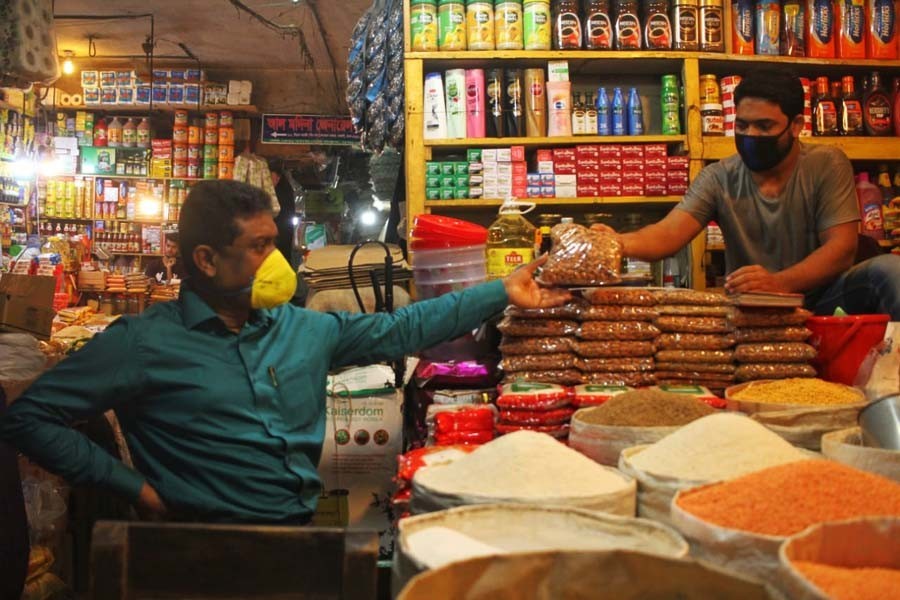
Published :
Updated :

It's Covid time. Life has never been so difficult. Families have lost their near and dear ones to the deadly virus---SARS-CoV-2. People in their thousands fought a hard battle with the pathogen and survived. Millions lost their jobs and sources of income in Bangladesh, as elsewhere in the world.
The virus is now on the retreat; it seems. The lull, however, could be temporary. An air of uncertainty is there. Yet, life is returning to normal slowly and economic activities have picked up. But it might take years to return to the pre-pandemic rhythm. The pandemic has given rise to many hurdles and everyone will have to deal with those on the way back to his/her normal life.
An unabated surge in the prices of daily necessities has been hurting most people, financially. Throughout the pandemic, essentials continued to be pricier unabatedly. Sometimes, international prices triggered the increase. But the increase was well beyond the justifiable level. As far as prices of essentials are concerned, it has been a free-for-all situation.
A comparison of the present prices of some key essentials with those of pre-pandemic time shows how big the differences are. The coarse variety of rice is now 31.5 per cent costlier than that of February last year. Flour (atta) prices are up by 20 per cent, finer flour (maida) 33 per cent, Soyabean oil 43 per cent, sugar 22 per cent, lentil 30 per cent, onion (local) 7.0 per cent and chicken (broiler) 52 per cent. Vegetables and fish are also pricier.
The household expenditures on account of LPG gas and toiletries, bakery items, transportation etc., have also recorded a notable rise. Official inflation data, however, do not represent the situation on the ground.
Undeniably, the global commodity markets are volatile, with prices of many items surging ahead. Production disruptions and soaring shipping charges are mainly responsible for the rise in prices. The international prices have influenced the domestic market. But factors such as hoarding and market manipulation by the unscrupulous section of traders are no less responsible for the current price situation.
Surprisingly, rice continues to be pricier when the country has reaped two bumper harvests and allowed the import of rice at reduced duty rates.
There should be no earthly reason for the rice prices reaching the current level. The government has been claiming self-sufficiency in food production. The private sector has also imported a substantial volume of rice following the duty reduction.
One has to get the arithmetic right. Statistics concerning the import of rice are available to the government. The directorate general of agricultural extension and the Bangladesh Bureau of Statistics do also collect statistics on rice acreage and production separately. All those do not indicate any supply shortage. The import cost of rice---most imports are done from neighbouring India--- is also far lower than the prevailing rice price in the domestic market. Then, why should the prices of rice be so high? Are the rice production data available to government agencies credible? The rice millers have lately emerged as a major force in the domestic rice market because of the government's heavy dependence on them for filling up the state silos. As widely suspected, are the millers responsible for the rise in rice prices?
Onion is another item that deserves a mention. The price of this pungent stem tuber shot up by 100 per cent within a week following a marginal rise in prices of onion in India. The domestic production of the item this year has been quite satisfactory. Moreover, traders have made a sizeable import of onion.
Only the government is in a position to provide an answer to questions about the rise in prices of rice or any other essential item. Unfortunately, the government has preferred to be indifferent, to a great extent. The men in charge of the relevant ministry and agencies remained, more or less, non-reactive to these pressing issues.
The government, on a very limited scale, has been selling some food items, including rice, sugar, lentil, onion and atta at subsidised prices. The open-market-sale (OMS) operation of the government does not have any impact on the overall price situation.
The authorities need to be a bit sympathetic towards the poor and middle-income people who are hard hit by the pandemic. The number of poor, according to a private think-tank survey, has gone up by 100 per cent. Their pandemic-hit employers cut the salary and wages of many. These people are finding it hard to get along with the prevailing price situation.
The government does not control the international prices of commodities. But it can surely monitor the local market and see whether the prices of various commodities are going through a commensurate hike or not. The relevant agencies can take action if anyone sets prices of commodities unjustifiably.


 For all latest news, follow The Financial Express Google News channel.
For all latest news, follow The Financial Express Google News channel.